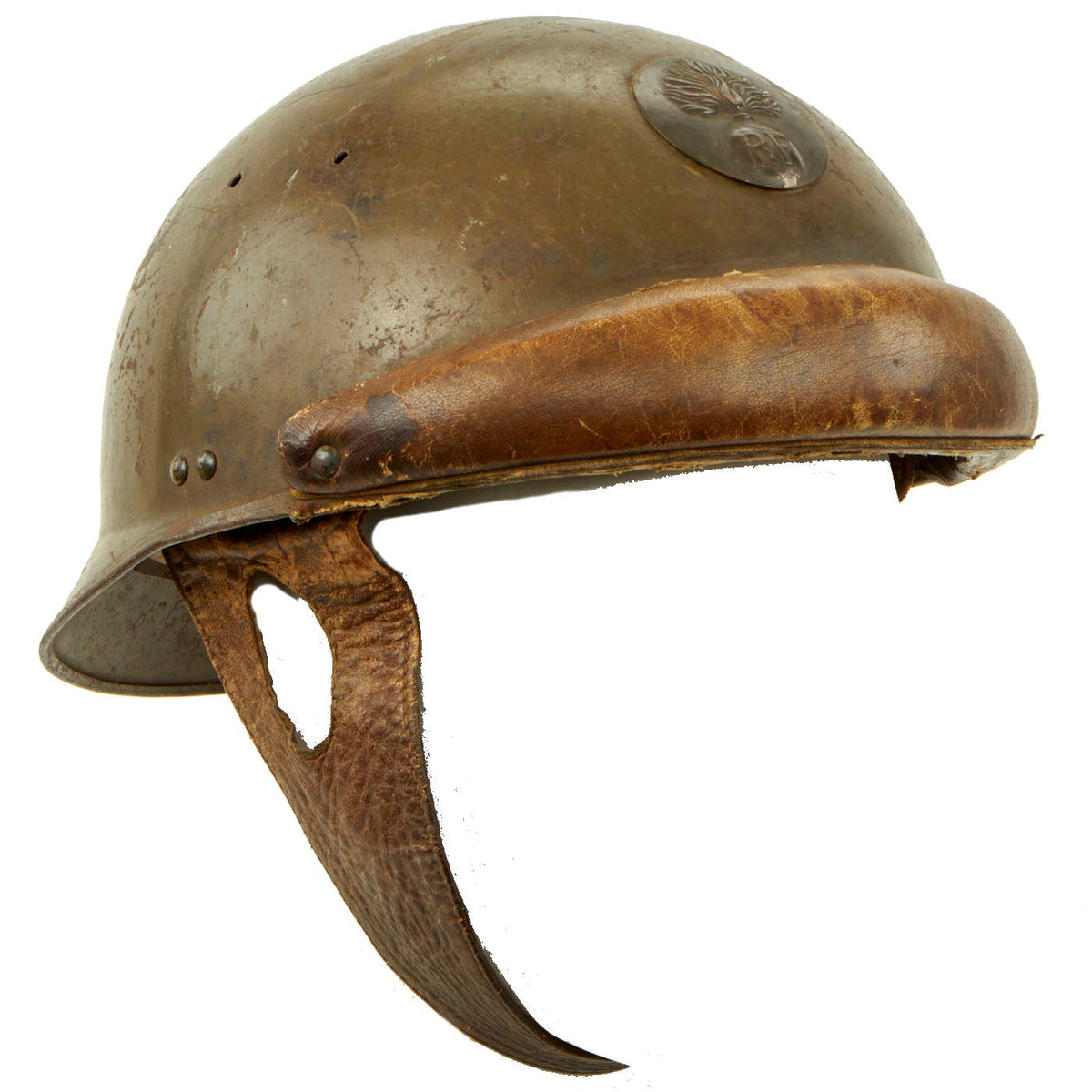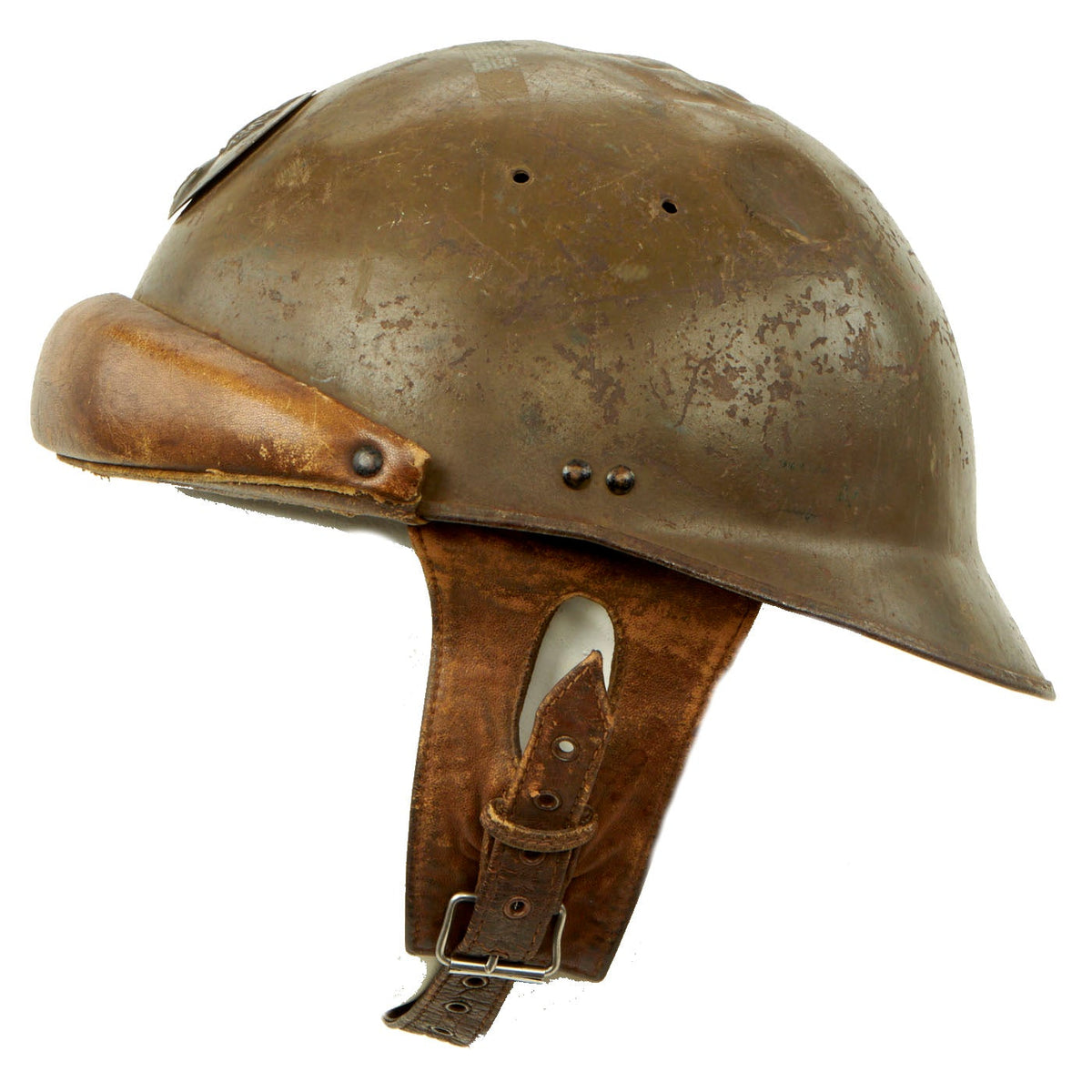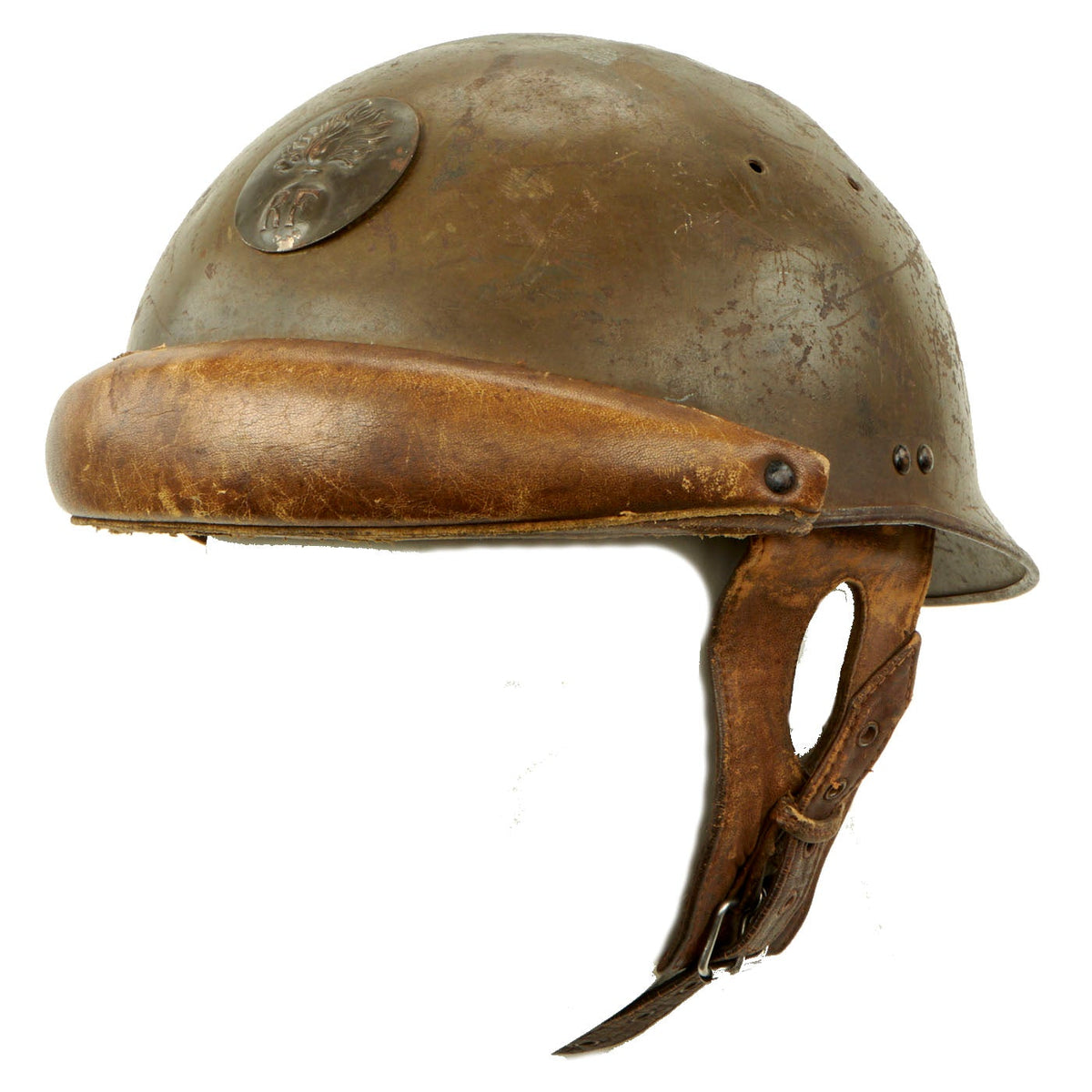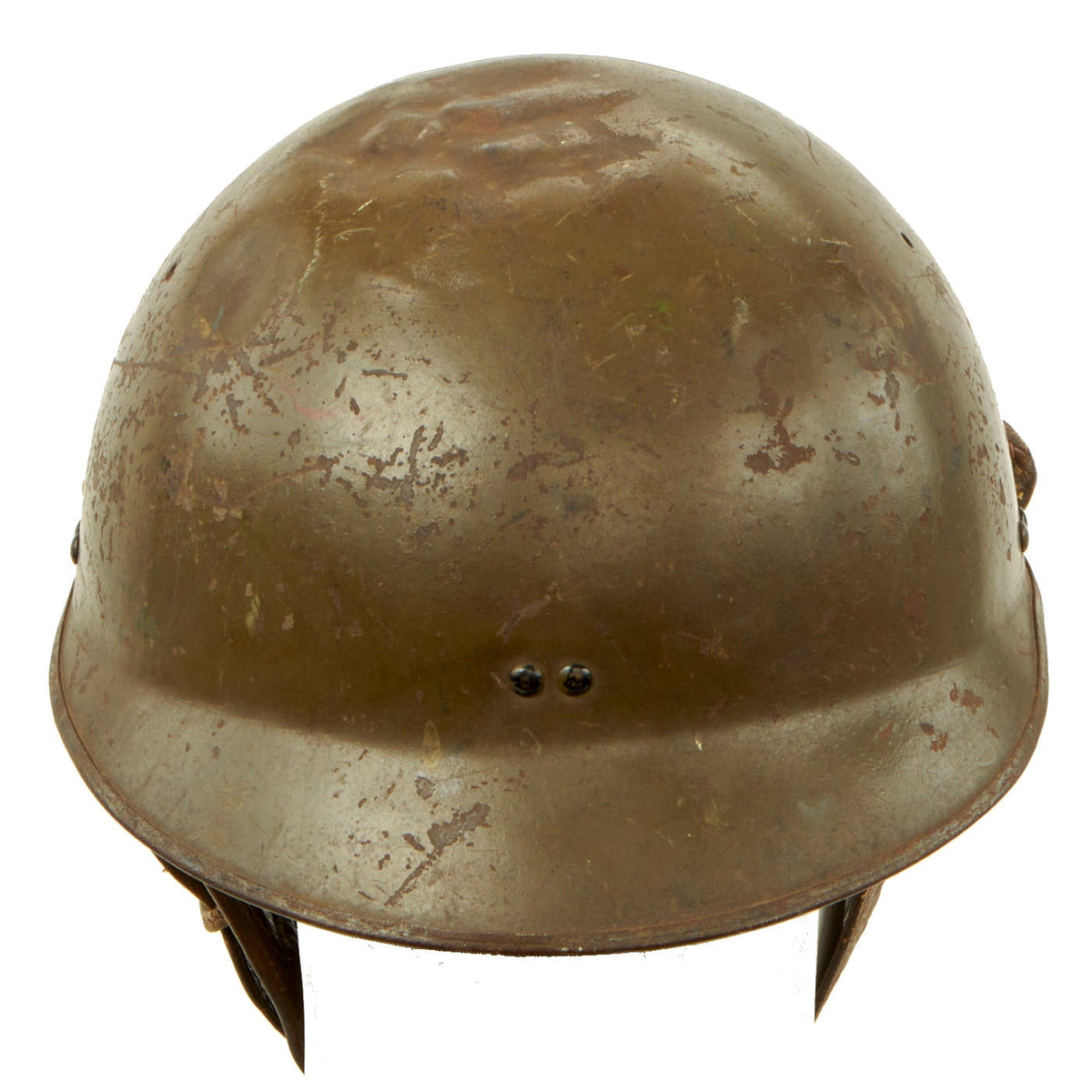Original French WWII Model 1935 Named Tanker Armored Vehicle Helmet with R.F. Badge Original Items
$ 595,00 $ 178,50
Original Item: Only One Available. This is a very difficult type of helmet to find, known as the Chars de Combat helmet or Armored vehicle helmet. Features a steel skull shell with rear visor and front leather brow pad. These helmets were issued to armored vehicle and tank crews in the French military before and during World War Two.
The helmet features much of its original paint and has an RF (République Française) flaming bomb badge on the front, the standard badge for the French Army. It also retains its original brown leather ear flapped liner with belt buckle style buckle, similar to British Dispatch rider helmets. Size is approximately a US 7 (56cm).
A scarce helmet to find and in very good service used condition. There is very slight, if any deterioration to the leather liner, and the front brow pad is still attached to the shell. It also has some dents in the top. On the skirt, etched in the paint on the underside is an initial, name and 4 digit number, barely noticeable and unable to be deciphered by us. This helmet was certainly present on the Maginot Line and in the early days of the fall of France 1940. This helmet has loads of patina and is ready to display!
French development into tanks began during World War I as an effort to overcome the stalemate of trench warfare, and largely at the initiative of the manufacturers. The Schneider CA1 was the first tank produced by France, and 400 units were built. The French also experimented with various tank designs, such as the Frot-Laffly landship, Boirault machine and Souain experiment. Another 400 Saint-Chamond tanks were manufactured from April 1917 to July 1918, however these tanks were largely underpowered and of limited utility due to the design of the caterpillar tracks, which were too short in comparison with the tank’s length and weight. The most significant French tank development during the war was the Renault FT light tank, which set the general layout for future tank designs and was used or redesigned by various military forces, including those of the United States.
At the start of World War 2, France had one of the largest tank forces in the world along with the Soviet, British and German forces. The French had planned for a defensive war and built tanks accordingly; infantry tanks were designed to be heavily armoured. Within France and its colonies, roughly 5,800 tanks were available during the time of the German offensive, and some when they came into contact were effective against the German tanks.
The R 35 was intended to replace the FT as standard light infantry tank from the summer of 1936, but even by May 1940 not enough conscripts had been retrained and therefore eight battalions of the older tank had to be kept operational. On 1 September 1939, at the outbreak of war, 975 vehicles had been delivered out of 1070 produced; 765 were fielded by tank battalions in France. Of a total order for 2,300 at least 1,601 had been produced until 1 June 1940 serial numbers known to be actually used indicate a production of at least 1670 vehicles.
In the Battle of France, despite an advantage in number and armour against the Germans, the French tanks were not used to good enough effect. Ironically, cooperation with the infantry was poor. The Cavalry units alone were too few in number.
In armour and firepower, French tanks were generally not inferior to their German counterparts. In one incident, a single Char B1 “Eure” was able to destroy thirteen German tanks within a few minutes in Stonne on 16 May 1940, all of them Panzer III and Panzer IV tanks. The 37mm and 20mm guns the Germans used were ineffective at penetrating the thick armour of the B1, which was able to return safely despite being hit a large number of times. Even German General Rommel was surprised at how the French tanks withstood the German tank shells and had to resort to using the German 88 artillery as anti tank guns against the French tanks to knock them out. Setbacks the French military suffered were more related to strategy, tactics and organisation than technology and design. Almost 80 percent of French tanks did not have radios, since the battle doctrine employed by the French military was more a slow-paced, deliberate conformance to planned maneuvers. French tank warfare was often restricted with tanks being assigned for infantry support. Unlike Germany, which had special Panzerwaffe divisions, France did not separate tanks from the Infantry arm, and were unable to respond quickly to the Blitzkrieg tactics employed by the Germans, which involved rapid movement, mission-type orders and combined-arms tactics.
Fast Shipping with Professional Packaging
Thanks to our longstanding association with UPS FedEx DHL, and other major international carriers, we are able to provide a range of shipping options. Our warehouse staff is expertly trained and will wrap your products according to our exact and precise specifications. Prior to shipping, your goods will be thoroughly examined and securely secured. We ship to thousands clients each day across multiple countries. This shows how we're dedicated to be the largest retailer on the internet. Warehouses and distribution centres can be located throughout Europe as well as the USA.
Note: Orders with more than one item will be assigned a processing date depending on the item.
Before shipping before shipping, we'll conduct a thorough inspection of the items you have ordered. Today, the majority of orders will be delivered within 48 hours. The delivery time will be between 3-7 days.
Returns
The stock is dynamic and we cannot completely manage it because multiple stakeholders are involved, including our factory and warehouse. So the actual stock may alter at any time. It's possible that you may not receive your order once the order has been made.
Our policy is valid for a period of 30 days. If you don't receive the product within 30 days, we are not able to issue a refund or an exchange.
You can only return an item if it is unused and in the same state as the day you received it. You must have the item in its original packaging.
Related products
Uncategorized
Uncategorized
Uncategorized
Uncategorized
Uncategorized
Uncategorized
Uncategorized
Uncategorized
Uncategorized
Uncategorized
Uncategorized
Uncategorized
Uncategorized
Armoured Fighting Vehicles of the World: AFVs of World War One (Hardcover Book) New Made Items
Uncategorized
Australian WWII Owen MK1 Machine Carbine SMG Custom Fabricated Replica with Sling Original Items
Uncategorized
Uncategorized












































































